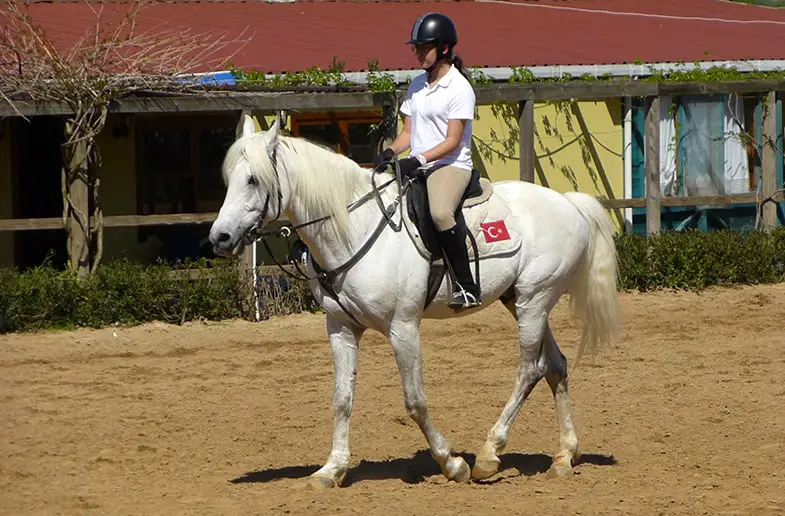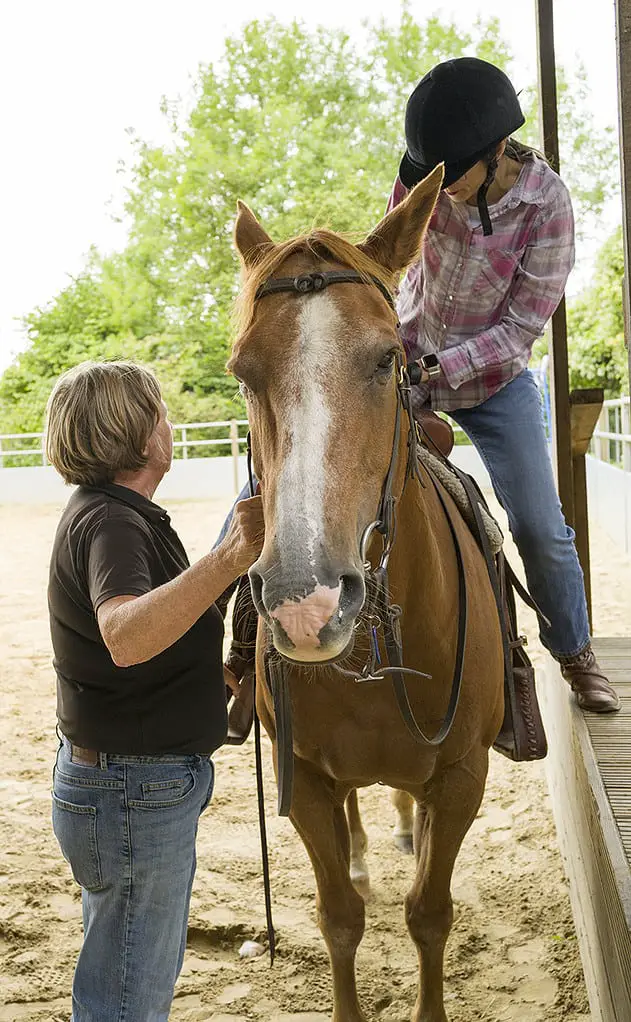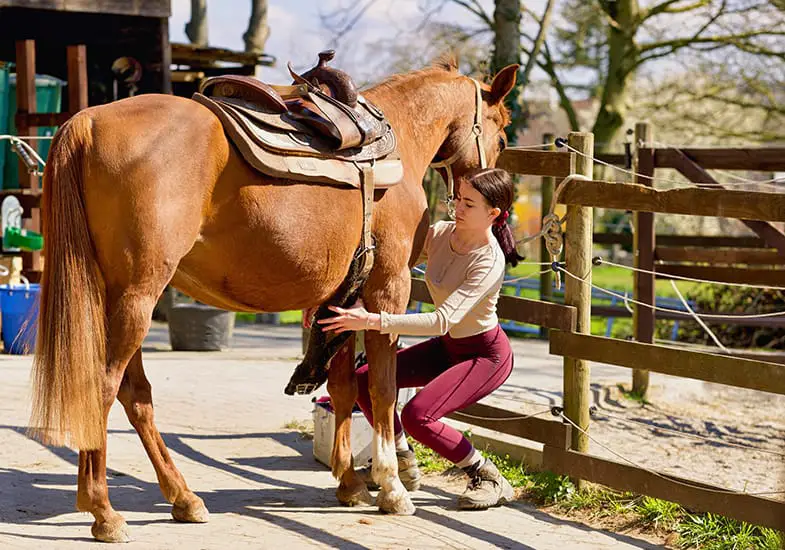If you’ve decided to learn to horseback ride, or if you’re thinking about it, you might be wondering what will happen in your first lesson and what you’ll be learning. As a riding instructor myself this is something I’m often asked which is why I thought it would be helpful to give a step-by-step guide to what you should expect on your very first horseback riding lesson.
What will happen during your first riding lesson? You’ll learn to groom a horse, tack them up (put the saddle and bridle on) and lead them as well. Once you mount (get on) the horse you’ll learn how to steer and stop them as well as how to ride at a walk. After the lesson, you’ll learn how to dismount (get off) and untack the horse.
First of all, I’d like to say welcome to the world of horses and congratulations on taking your first step into a wonderful world where you’ll make lifelong friends and have a lot of fun.
I’ve spent the last few decades teaching people to ride but I always start every first-time rider in the same way, and that is with an extra 15 to 20 minutes in the first lesson. The reason for this is so that they can learn about grooming, tacking up, and leading a horse as well as get to know the horse they’ll be riding a little.
Preparing for your first horseback riding lesson
In the days (or weeks) running up to your first horseback riding lesson, you should make sure you have the right clothes to wear. You don’t need to spend a fortune buying a whole new outfit but it’s important that you have boots that have a small heel and pants that don’t have an inner seam. In terms of a riding helmet, it’s not essential that you have your own as your riding instructor will have ones that you can use.
Not sure what you can wear? A beginner’s guide to horseback riding attire.
I know you’ll be excited (and may even be nervous) but try and get a good night’s sleep before your first lesson. It’ll help you to concentrate better but more importantly, it’ll allow you to fully enjoy your experience. It’s also a good idea to keep yourself properly hydrated, especially if you’re riding in the summer and are in the open.
You shouldn’t eat a big meal before your lesson (doing so can increase the chances of a stitch and will also make you feel uncomfortable) but having something to eat so that you’re not hungry is beneficial.
If you’re not sure about anything ask, it’s human nature to be nervous when you’re doing something for the very first time but don’t worry this is perfectly normal and your instructor will be able to reassure you if you’re worried about anything in particular.
Don’t understand what your instructor is talking about? Learn the horse riding jargon.
What happens when you first arrive?
When you first arrive at the stables your instructor will greet you and help you find a suitable riding helmet if you don’t already have your own. Some instructors also have a few pairs of boots for people who’ve turned up wearing sneakers or other unsuitable footwear.
Once you’ve found a helmet you’ll be introduced to the horse you’ll be riding. If you’re nervous don’t worry, your instructor will have picked a sensible, mature horse that will understand it’s your first lesson so will be patient.
What will you learn in your first horseback riding lesson?
Every riding instructor is different and may approach things differently but in general they’ll all teach you the same things in the same order.
1) How to clean and groom a horse
Before you can even think about getting on the horse you’ll need to make sure his coat is clean and free of dirt, dried sweat, and mud, especially under the saddle and bridle areas. Not doing this can cause the horse sores, skin issues, discomfort, and in some cases pain.
As well as learning how to groom the horse and pick out their hooves (clean their feet) you’ll learn all of what all of the different types of brushes are and what they’re used for.
Don’t worry if you don’t remember what everything is or what it does at first, it can take a few lessons before you start to instinctively know what’s what.
Want to know more about grooming? How to groom a horse like a pro.
2) How to tack up a horse
Not only will you learn how to put all of the tack on the horse but you’ll also learn what every item is and what its purpose is.
If you’re young or aren’t tall enough to reach your instructor will tack the horse up for you but they’ll still show you how to do it properly.
Not sure what tack a horse needs? Everything you’ll need to ride.
3) How to lead a horse on a rope
Once the horse is tacked up you’ll be asked to lead them into the arena and walk them around for a few minutes. This gives you the opportunity to get to know the horse a little but it also gives the horse the chance to get to know your voice.
You’ll also learn how to use verbal cues to let the horse know what you want them to do, cues such as ‘whoa’ when you want them to stop or a click when you want them to move forward are commonly used.
4) How to get on (mount) a horse
Once the horse is tacked up you’re ready to get on and begin your riding lessons but before you do that your instructor will teach you how to mount a horse properly. Most instructors will ask you to use a mounting block (a block that has steps to allow you to get on easily) but if not they’ll show you how to get on from the ground.
Mounting from a block is easier for you but also puts less strain on the horse’s back. That said though, it’s always a good idea to learn how to mount from the ground in case you have to dismount (and then get back on) while you’re riding out.
If you’re asked to mount from the ground and are finding it difficult don’t worry your instructor will help you by giving you a leg up.
Once you’re on the horse your instructor will check the length of your stirrups (adjusting them if necessary) and make sure they’re the right length for you, and that they’re comfortable for you.
5) How to hold and use the reins
Now that you’re on the horse and are sitting comfortably your instructor will show you how to hold the reins correctly as well as how tightly to hold them. You don’t want to hold them so tight that the horse can’t move his head nor do you want to hold them so loosely that they slip out of your hands.
You’ll also learn where to put your hands and how to use the reins without pulling on the horse’s mouth and hurting them.
6) How to sit on a horse properly
Before you start moving your instructor will show you how to sit properly on the horse. At first, this will feel very alien but don’t worry you’ll soon get used to it.
Believe it or not, sitting properly in the saddle is one of the most important things you can do, but surprisingly it’s one of the hardest things to learn at first, especially as the horse starts to move. You’ll be nervous which will make it harder for you to relax but the more you tense up the more you’ll feel unbalanced and the more nervous you become.
The best way to maintain your posture is to breathe! I know that sounds silly because you do it all the time but by thinking about your breathing, and by taking deep breaths, you’ll automatically help your body to relax.
Want to maintain your posture in the saddle? How to improve and maintain your position.
7) How to use your body to control the horse
There’s a common misconception that the horse does all of the work and the rider just sits there but this couldn’t be further from the truth. You’ll learn how to use your whole body to control the horse’s speed, direction, and even when they stop.
Known as ‘aids’ you’ll learn how to use your legs to ask the horse to move forward as well as change direction, you’ll also combine this with your hands and your seat to stop the horse. You’ll also learn how to use your hands and seat to move the horse backward.
8) How to ride a horse at a walk
Once your instructor is happy that you’re sitting properly and not pulling on the reins you’ll be able to move forward. At first, this will just be a walk but it’ll give you a chance to practice what you’ve already learned about your aids and posture.
Some instructors will start you off on a lunge line (a long line that attaches to the bridle and allows your instructor to control the horse) or will lead the horse. This allows them to control the pace and direction of the horse so that you can concentrate solely on your balance and posture.
Want to know more about walking? Riding a horse at a walk.
9) How to stop (and control) a horse
While your instructor will have already told you how to stop the horse you won’t be able to put it into practice until you start moving.
As part of learning how to stop and control the horse, you’ll learn to use physical (your body) and verbal (your voice) cues together to control the horse.
Want to know more about stopping a horse? Learn how to stop a horse.
10) How to steer a horse
As well as learning how to stop the horse you’ll also learn how to ask them to go in the direction you want them to go in. You’ll also learn how to prevent them from wandering off in whatever direction they want to.
11) How to ride a horse at a trot
Once you’ve learned how to control the horse and can maintain your posture as the horse moves your instructor might suggest you have a little trot. This is a bit faster than a walk but a lot more bouncy but don’t worry if you relax you’ll be fine.
It’s worth pointing out though that while this might happen in your first lesson it’s more likely that you won’t start trotting until your second or third lesson.
Keen to learn how to trot? How to ride a horse at a trot.
12) How to dismount
At the end of your lesson, you’ll learn how to get off of the horse safely. If your lesson was the horse’s last one of that day you may also learn how to untack them before grooming them again.
After your first horseback riding lesson
After your lesson, you may want to give the horse a carrot, apple or horse treat but it’s important to ask your instructor if this is okay first. Some horses have controlled diets and feeding them something that isn’t part of this could make them unwell.
Not sure how to feed a horse treats? Dos and don’ts of feeding horse treats.
Further reading
If you enjoyed this article you may be interested in these:
I hope you found this article helpful. If you did I’d be grateful if you could share it please as it would really help me.
Recommended products
Over the years I have tried hundreds of different horsey products, from various blankets and halters to different treats. Some I’ve loved, others I’ve hated but I thought I’d share with you my top all-time favorite products, the ones I never leave the yard without. I’ve included links to the products (which are in no particular order) that I really think are great.
- Horse Knots by Reference Ready – If you’re like me and enjoy pocket reference guides then you’ll love this knot tying guide. These handy cards can easily fit in your pocket or attach to the saddle for quick reference. They’re waterproof, durable and are color coded to make them easy to follow.
- Mane ’n Tail Detangler – Even if you never show your horse you’ll need to detangle his tail from time to time (and possibly his mane too) which is always a challenging chore! I’ve found that if I run a little bit of detangler through my horse’s tails every few days it stops them from getting matted up and makes combing them easy, even if they’re coated in mud. I don’t know if I should admit to this or not but it also works wonders on my hair.
- TAKEKIT Pro clippers – Over the years I’ve tried a lot of different clippers and while some were obviously better than others I found these to be by far the best. They are heavier than a lot of other clippers but for me, that’s a good thing, it makes them feel more sturdy and hardwearing. On top of that they have a range of speeds so are just as good for clipping your horse’s back as they are his face. I also like the fact that they come in a handy carry case but that’s not for everybody. The company that makes them is super good and incredibly helpful too, a real bonus these days. The only thing I wasn’t keen on was the fact that it doesn’t come with any oil, but that’s not a major problem as it’s not difficult to buy lubricant.
- Shire’s ball feeder – There are so many boredom buster toys out there but I like to use these every day, regardless of whether or not my horses are bored. I find that it helps to encourage my horses to problem solve by rewarding them with treats (or pieces of fruit) but it also mimics their natural grazing behavior which helps to keep them calm and de-stressed.
- Horse safe mirror – This is a strange one that many people are surprised about but I like to put horse safe mirrors in the trailers as well as in the quarantine stalls. It helps to prevent the feeling of isolation by giving the impression of other horses being around. Being herd animals horses can get extremely stressed when they feel that they’re on their own but with these stick-on mirrors, they believe that at least one other horse is with them.
- Rectal thermometer – I know this isn’t glamourous at all but it’s vital for your horse’s well-being to be able to check their temperature and a rectal thermometer is the easiest way of doing this which is why I’ve added it to the list.
Shopping lists
I’ve also put together a few shopping lists of essential items that I’ve found helpful over the years. I’ve broken the lists down into different categories rather than put everything in one massive list 😉






